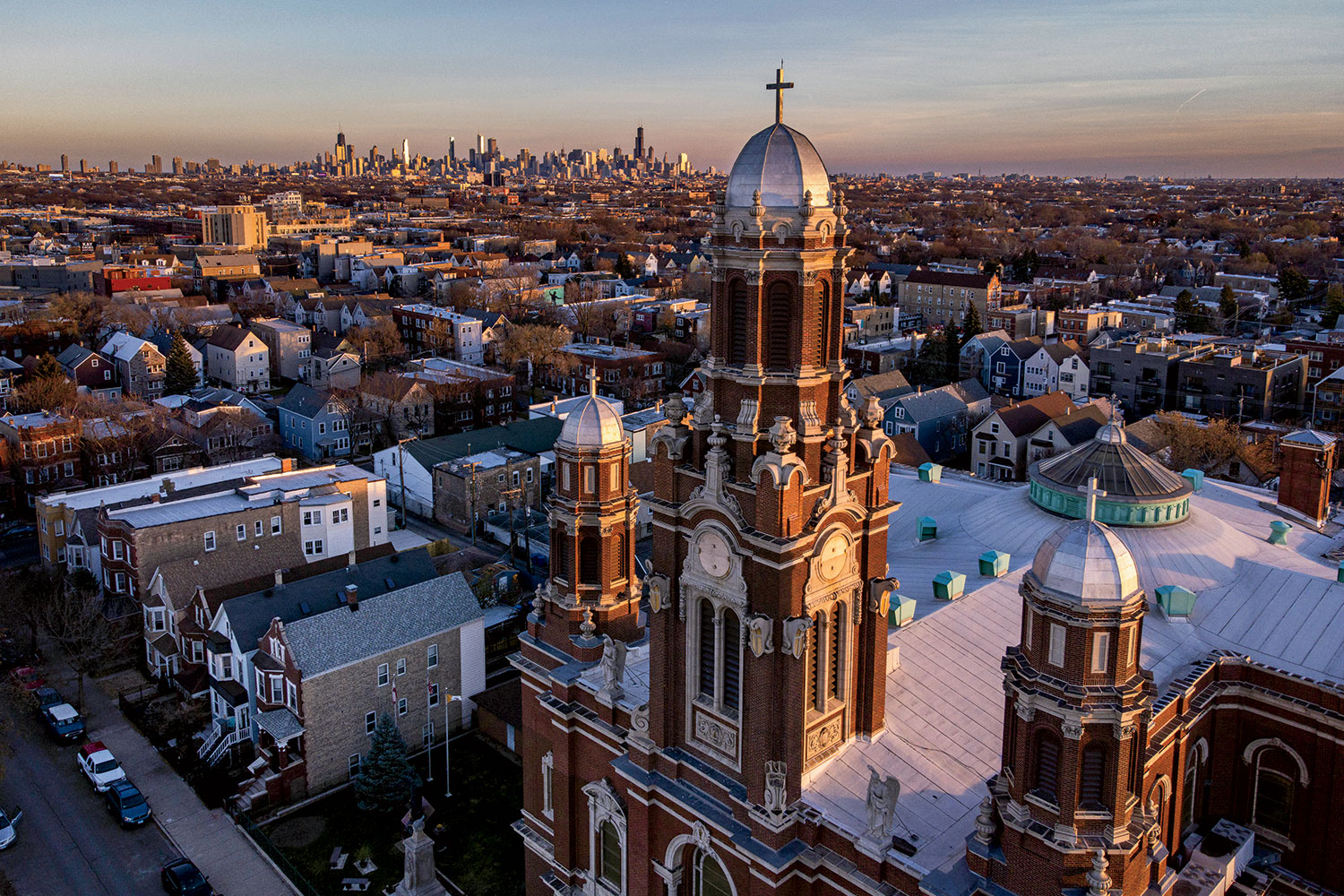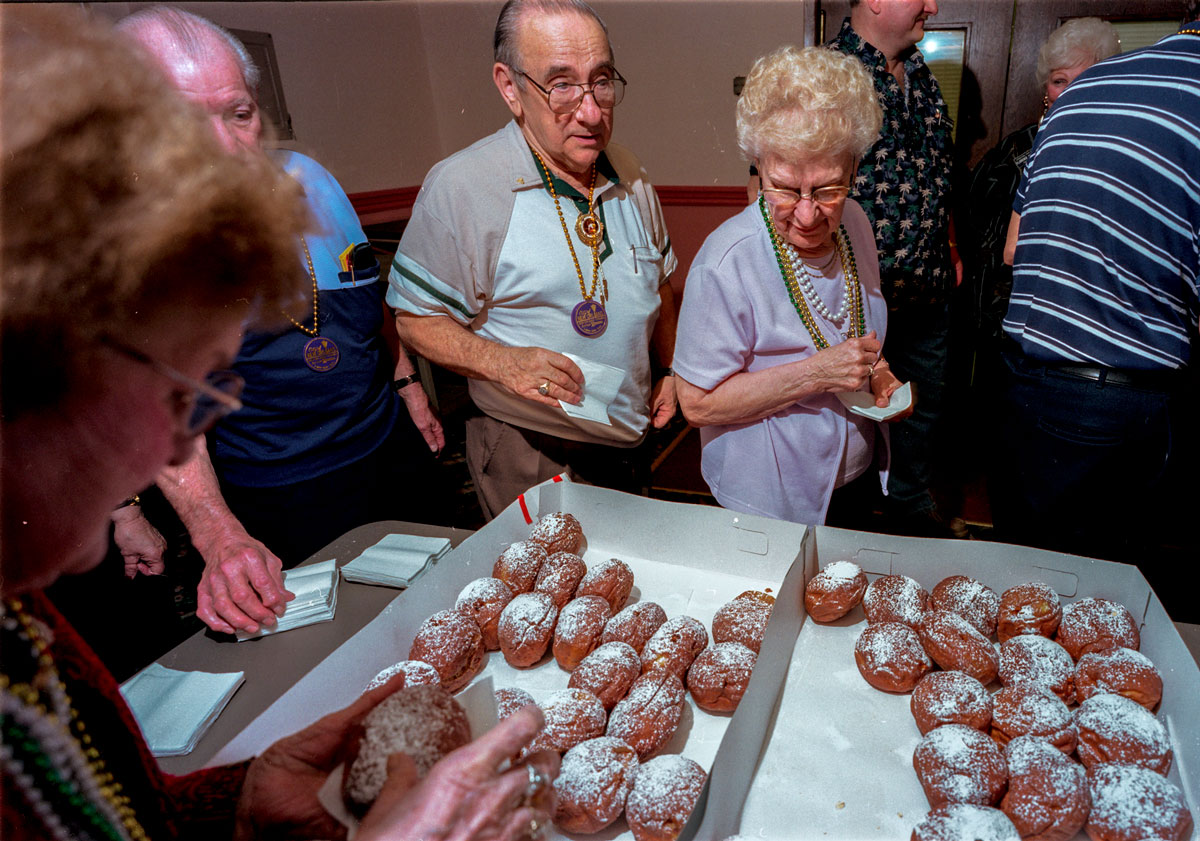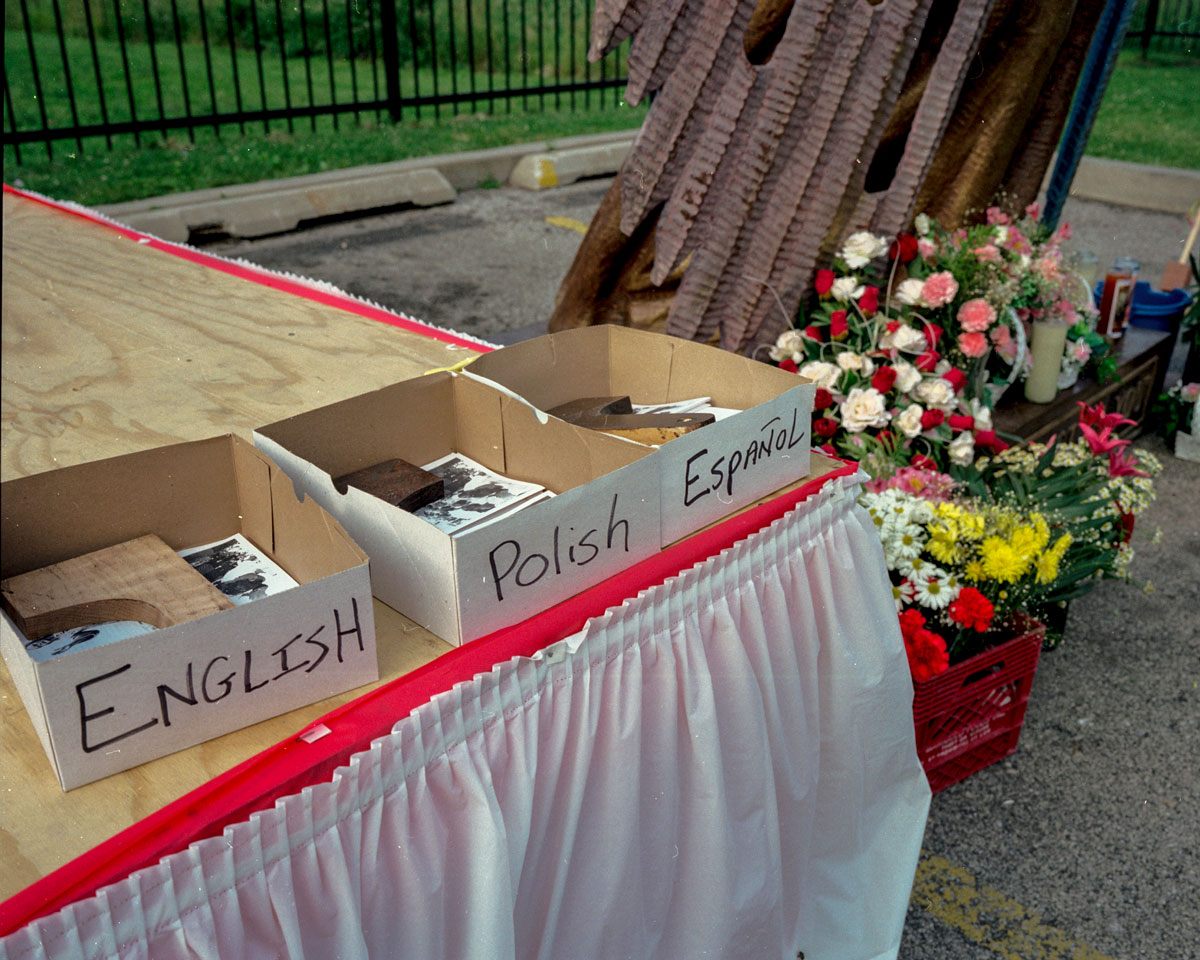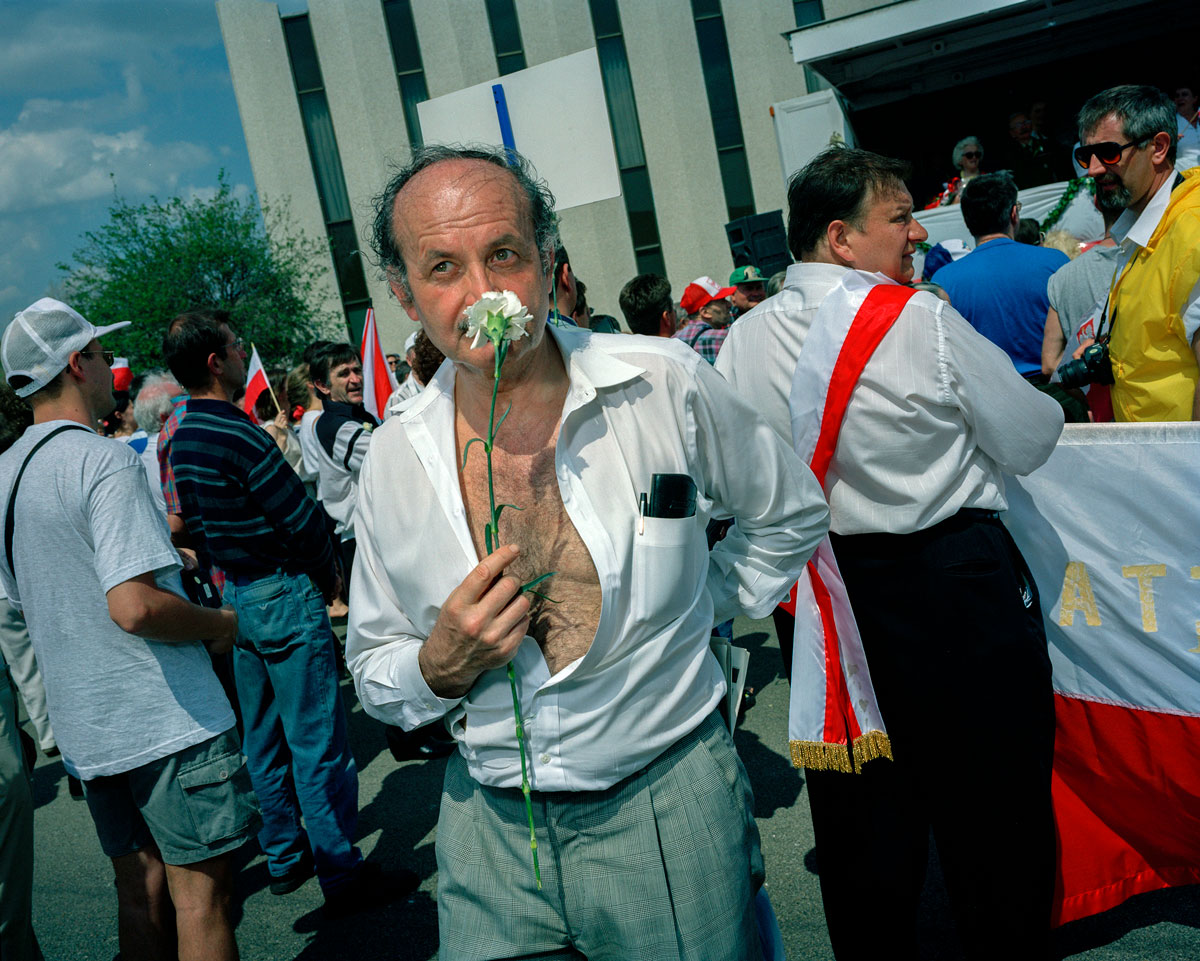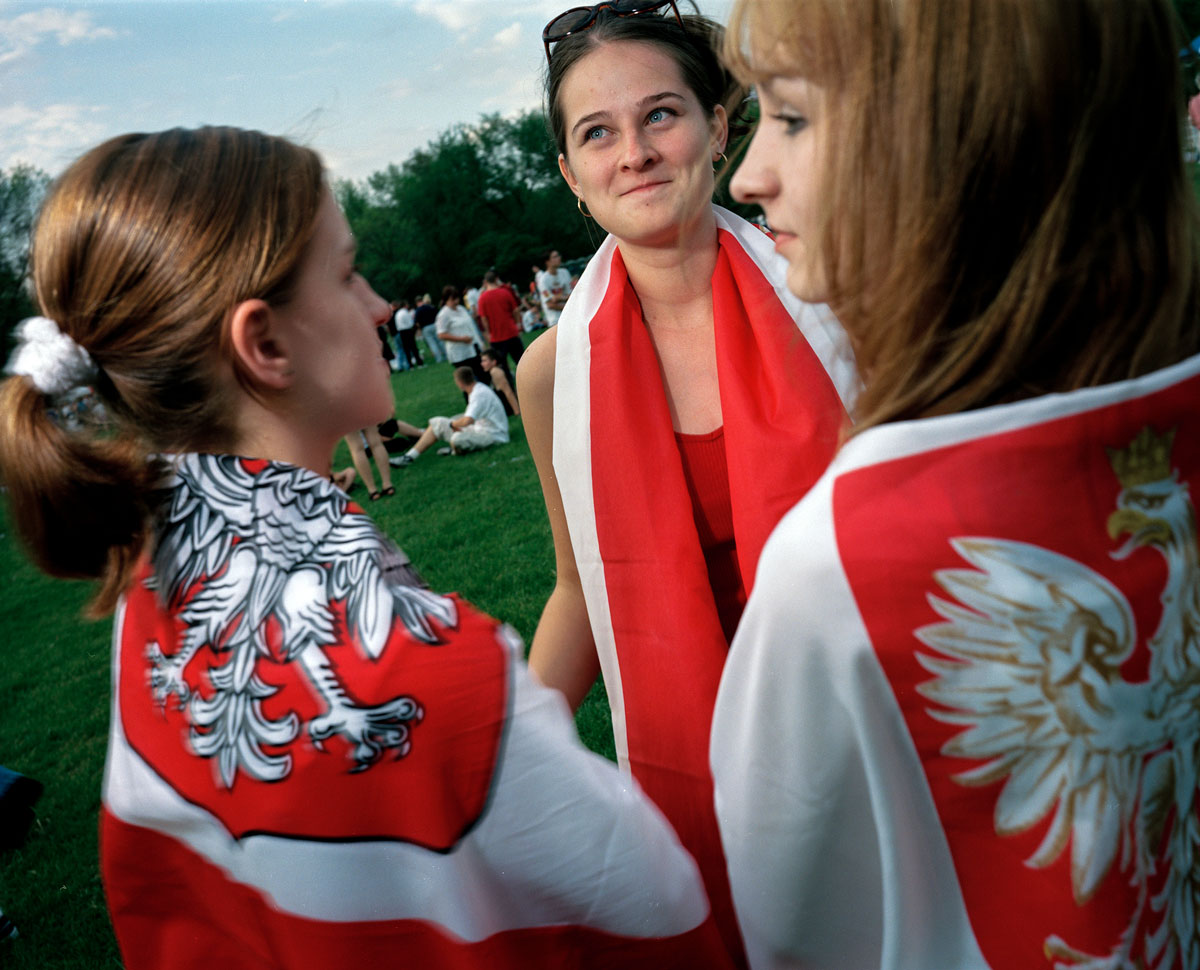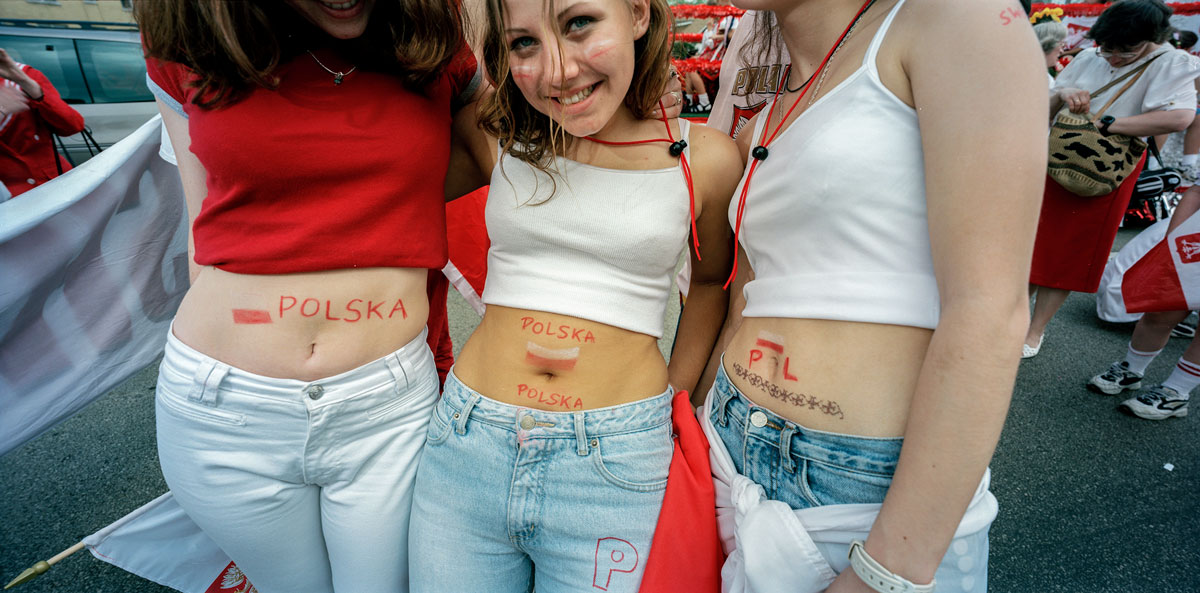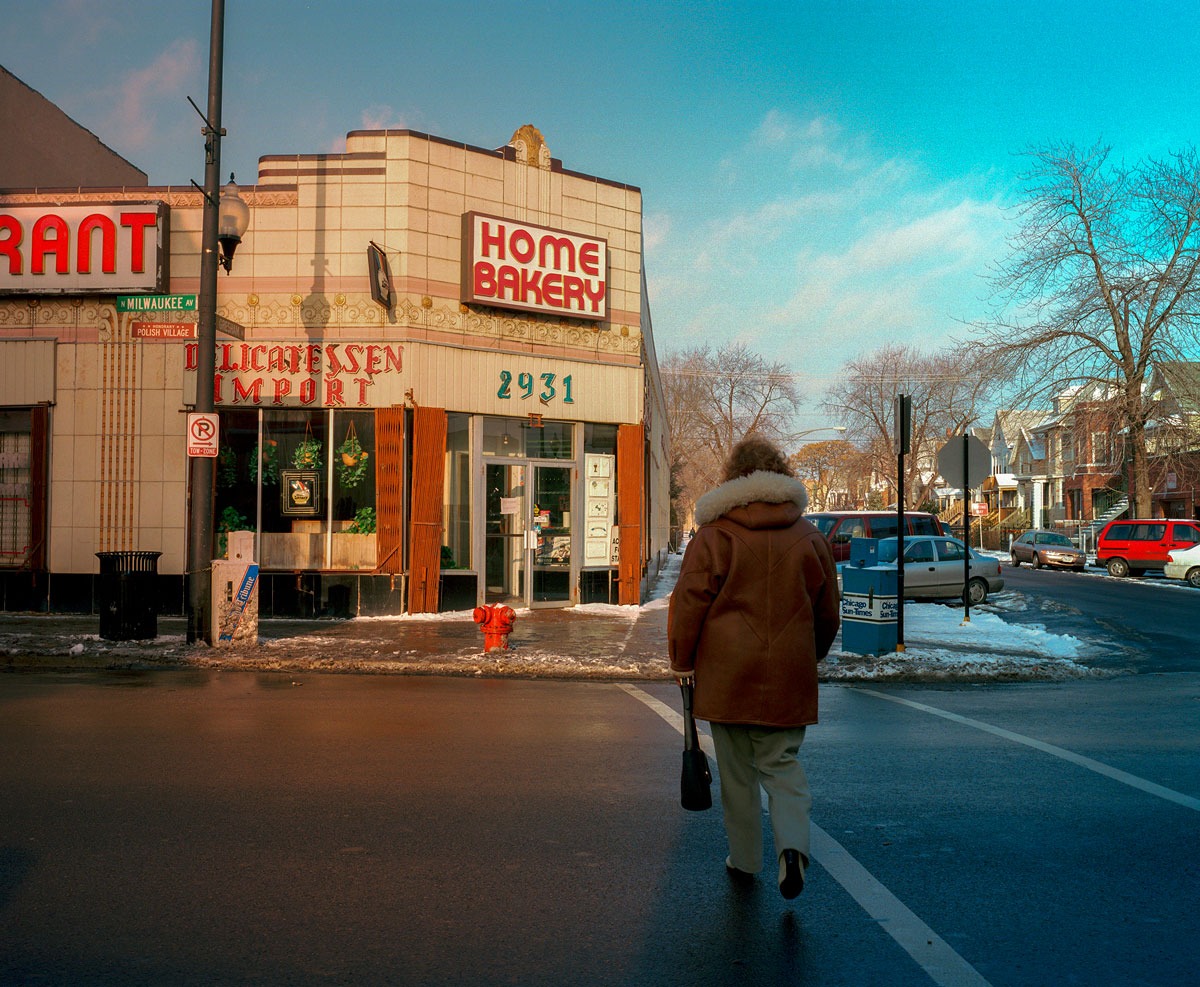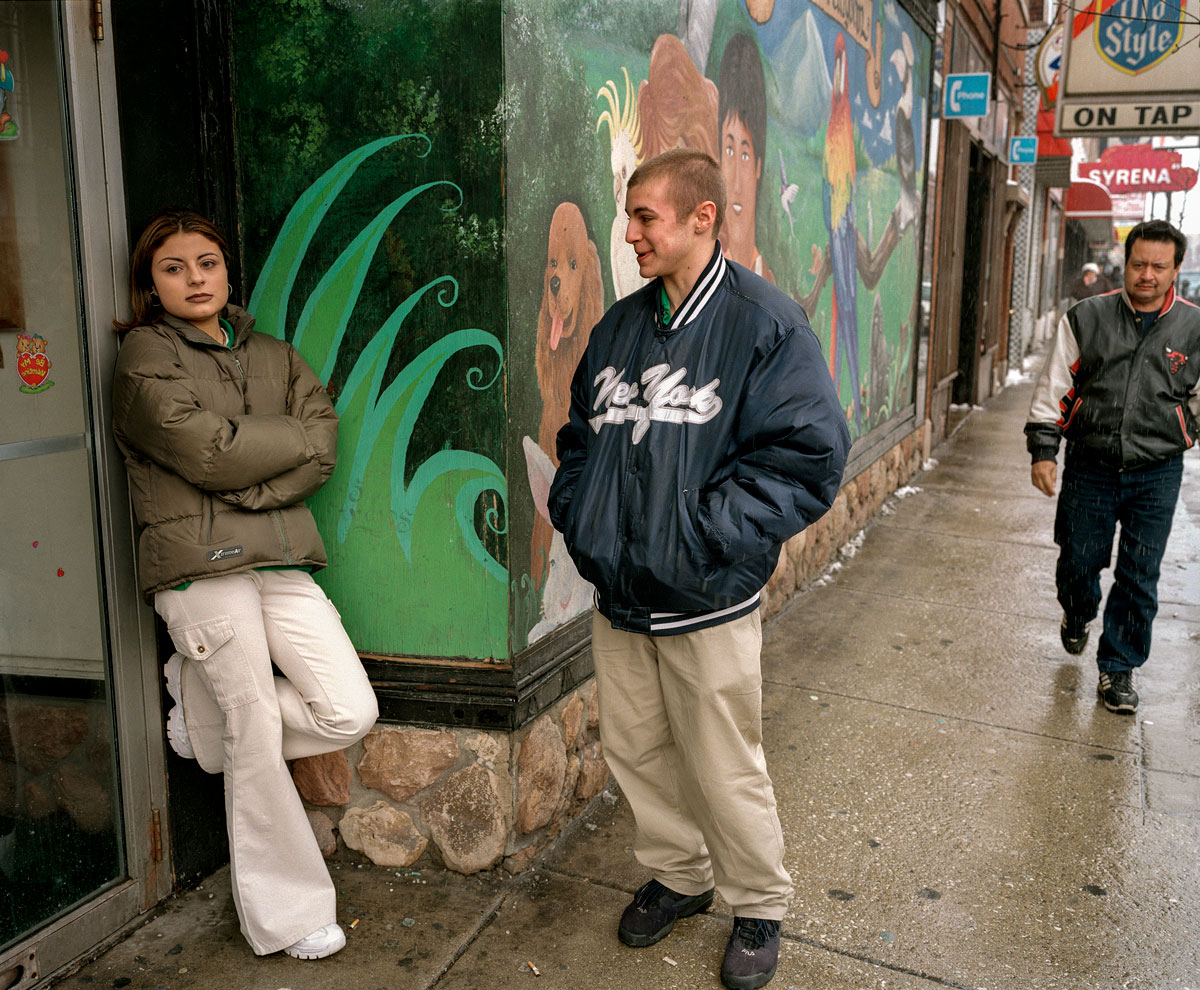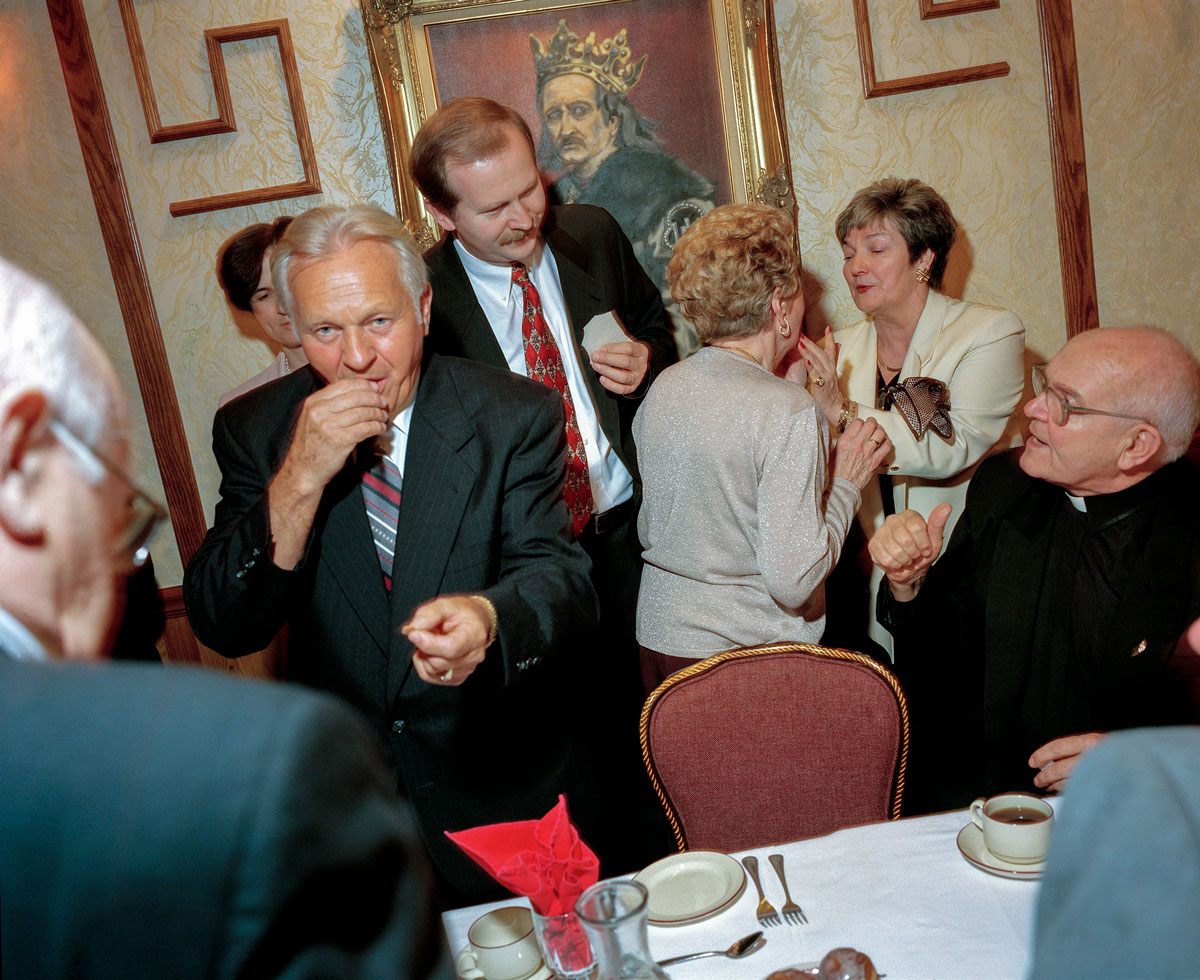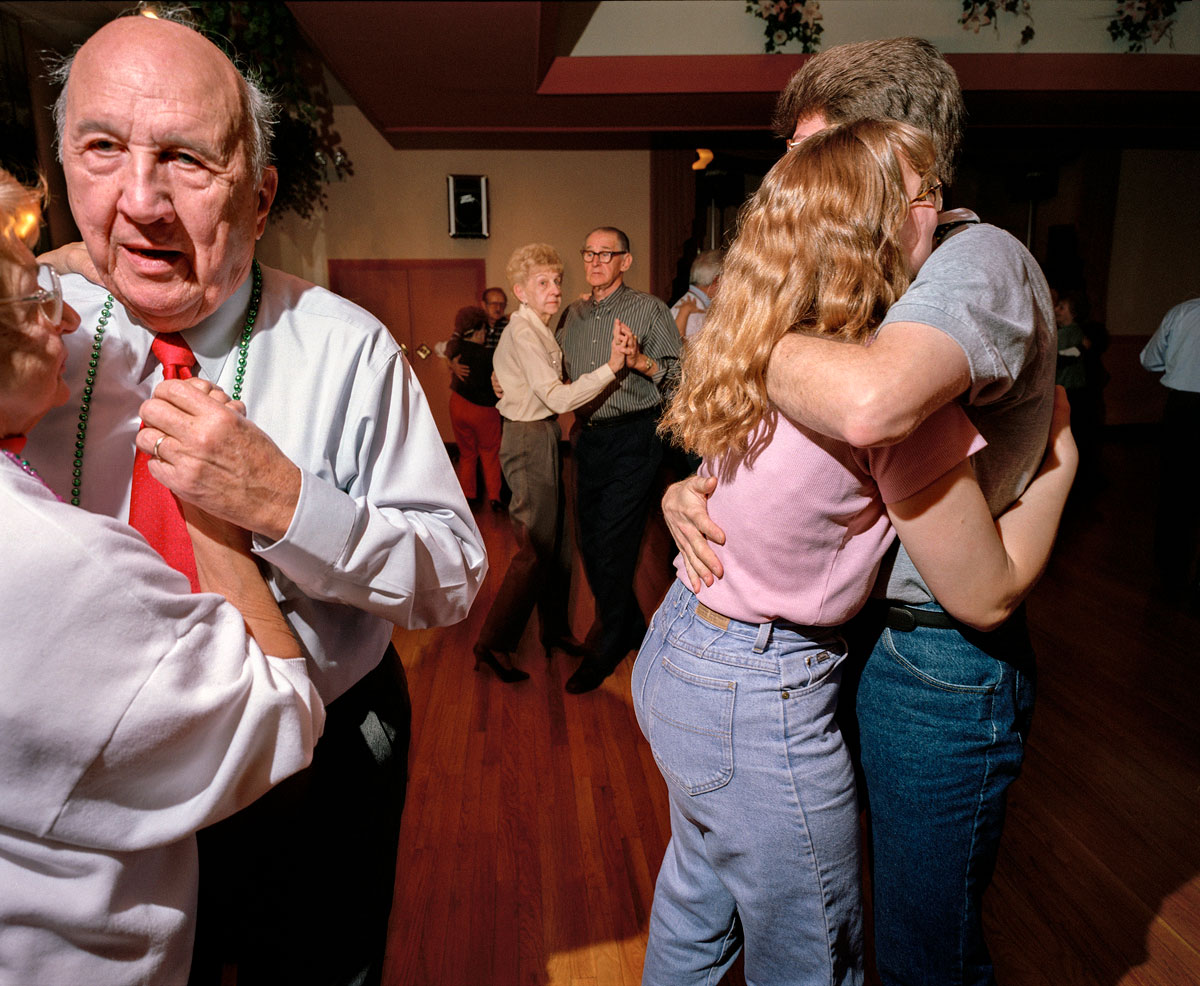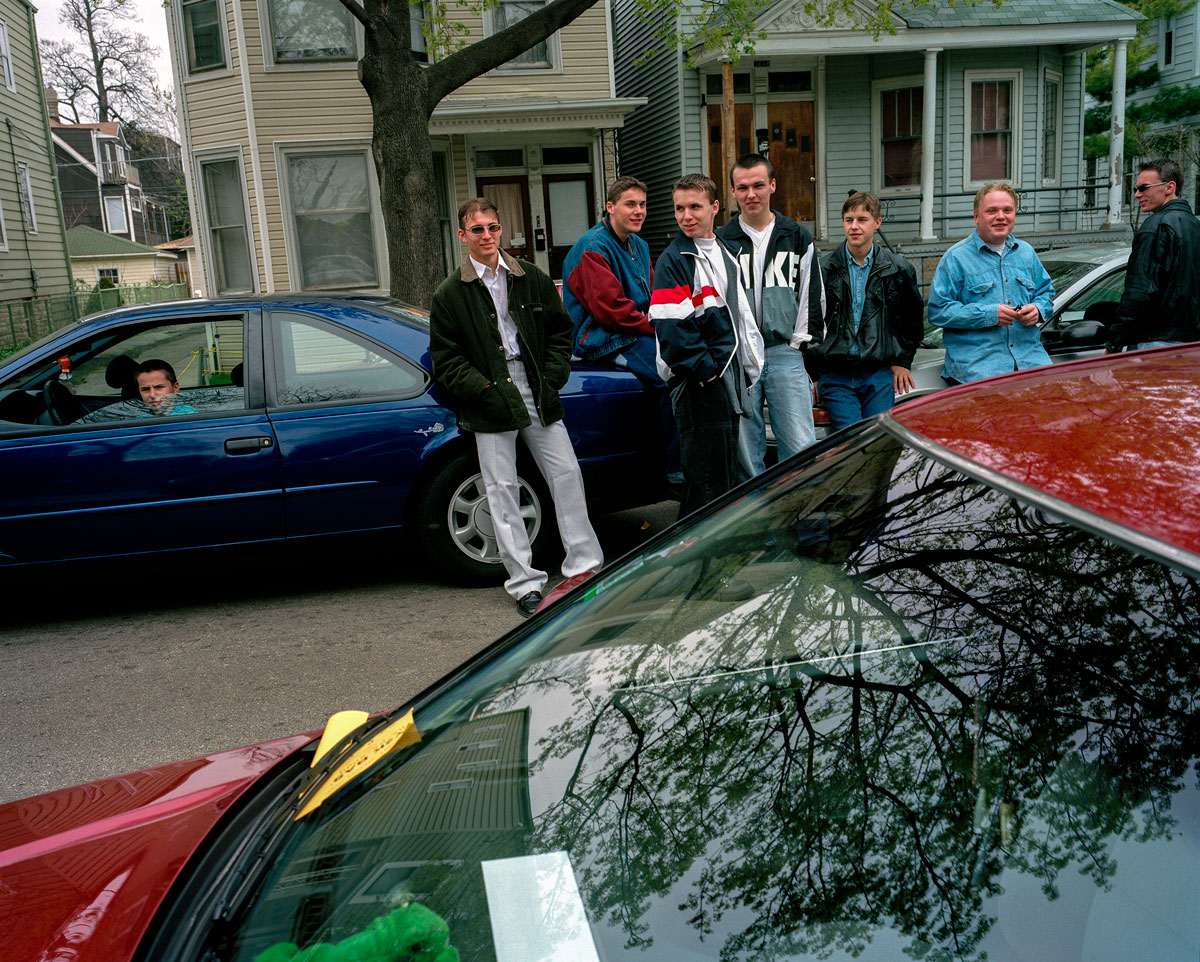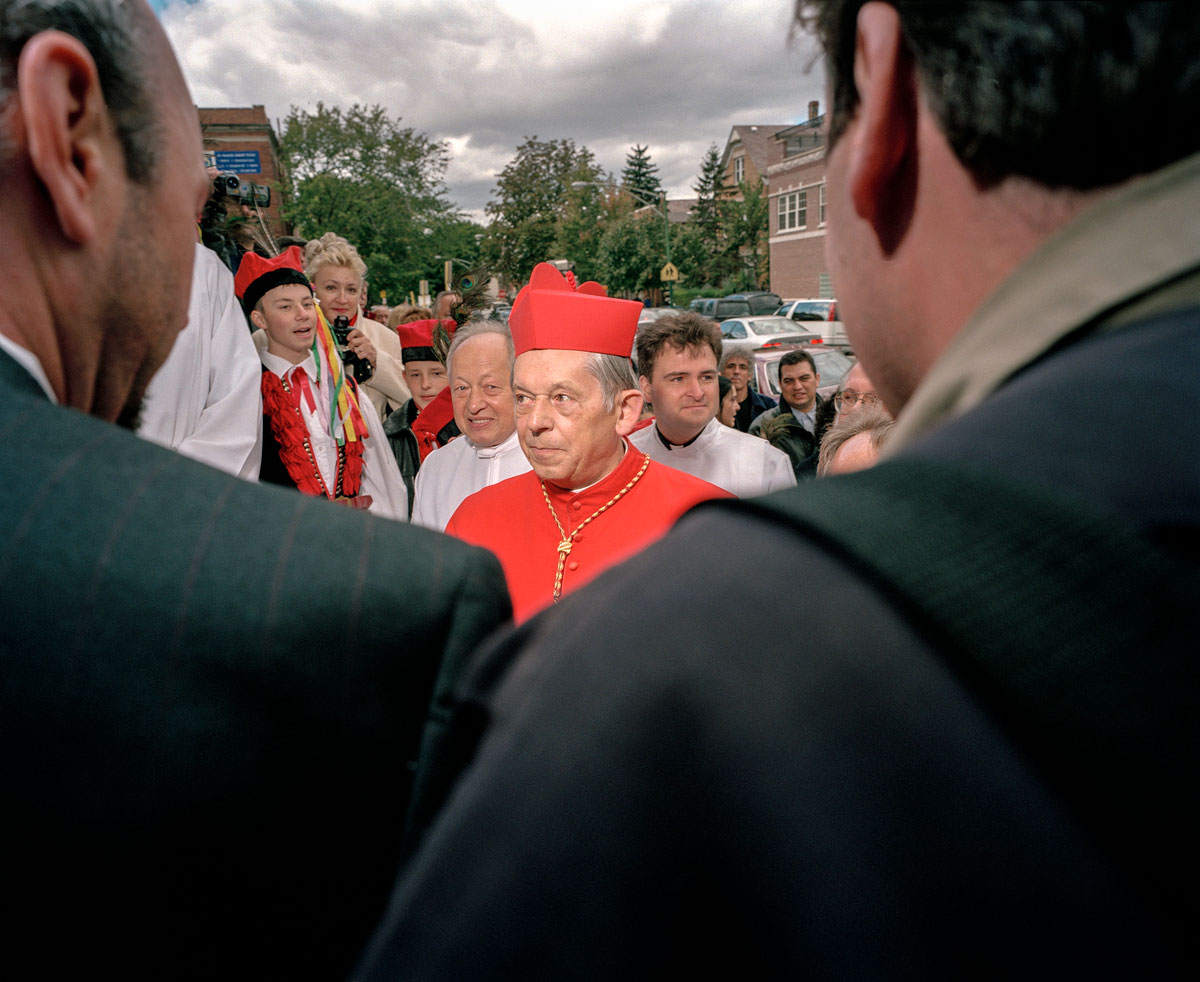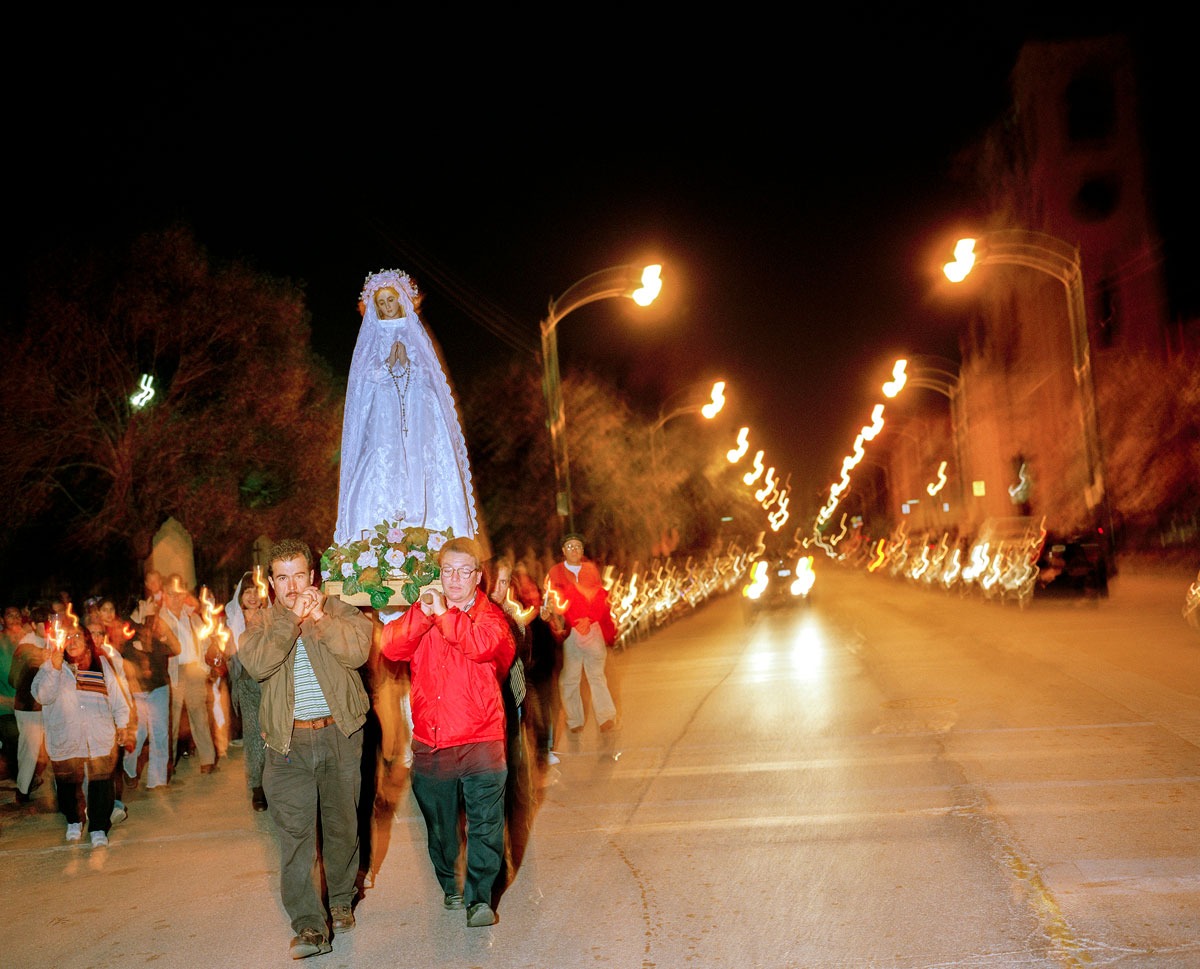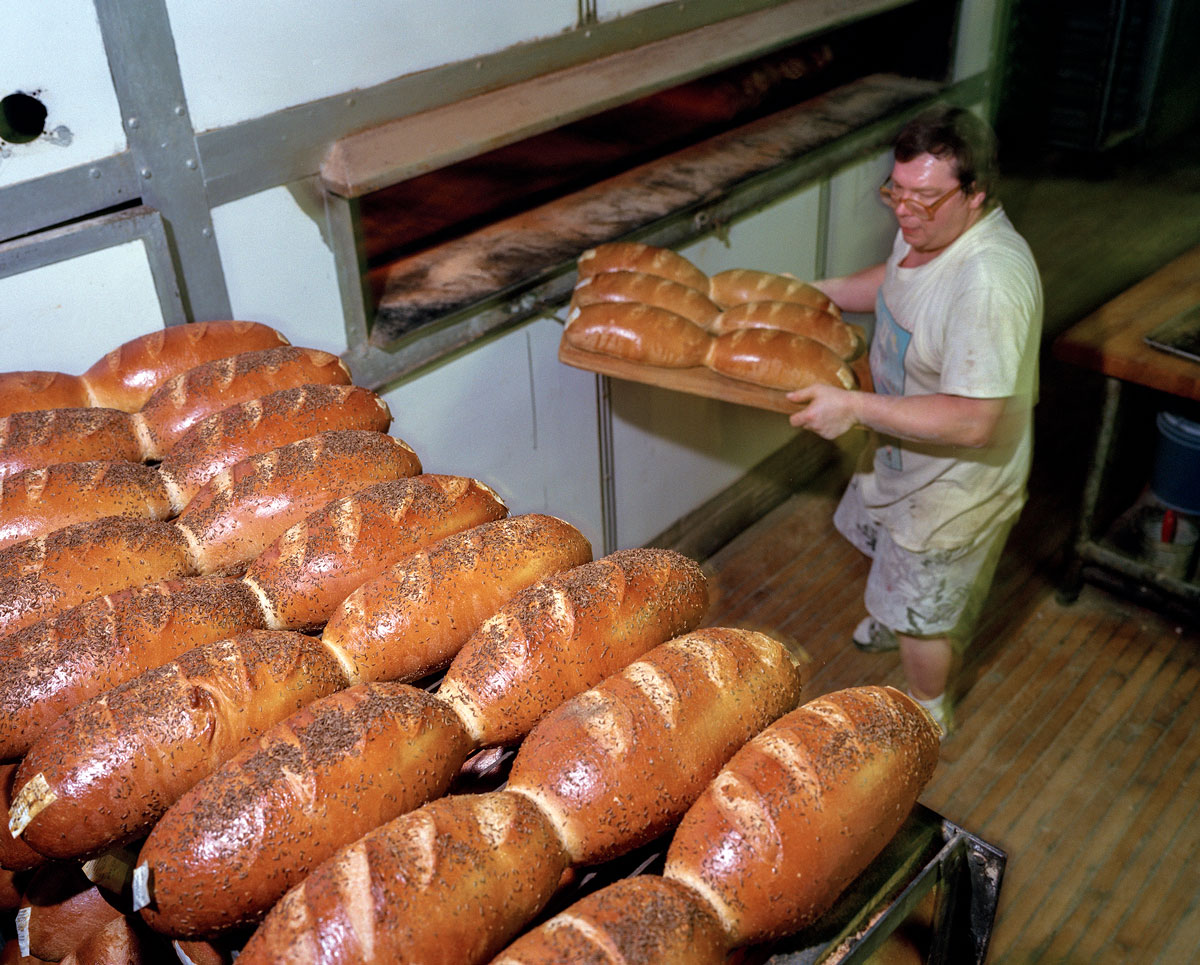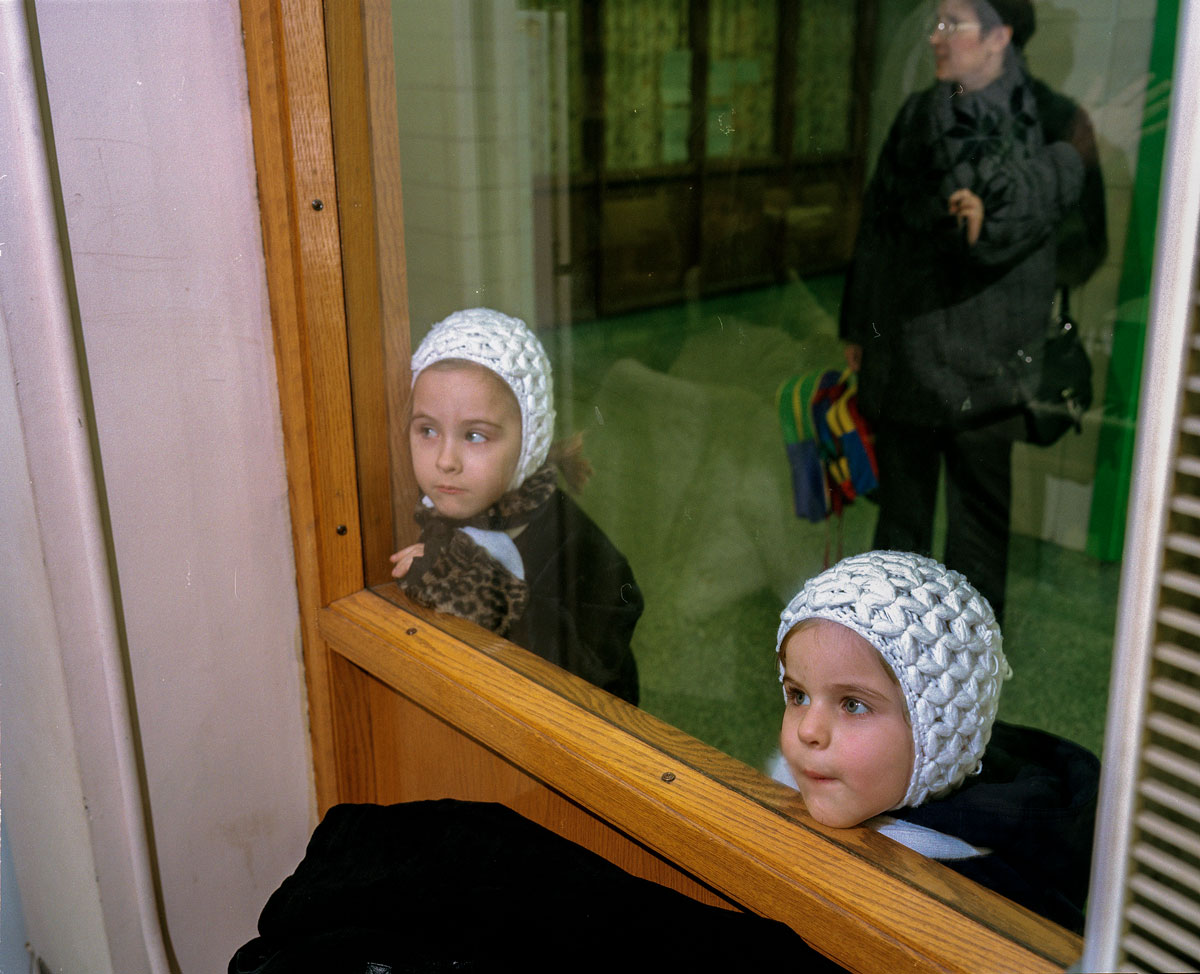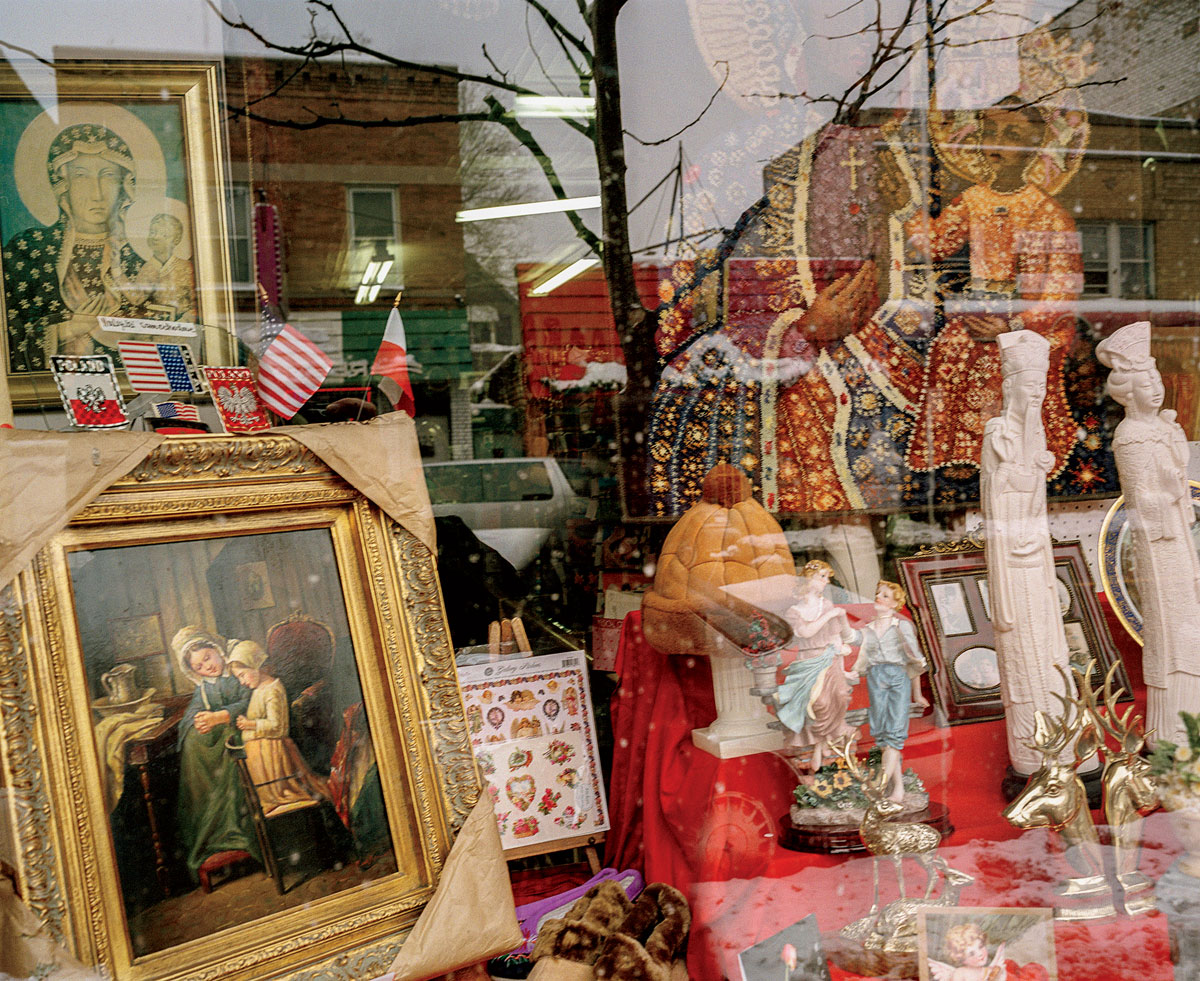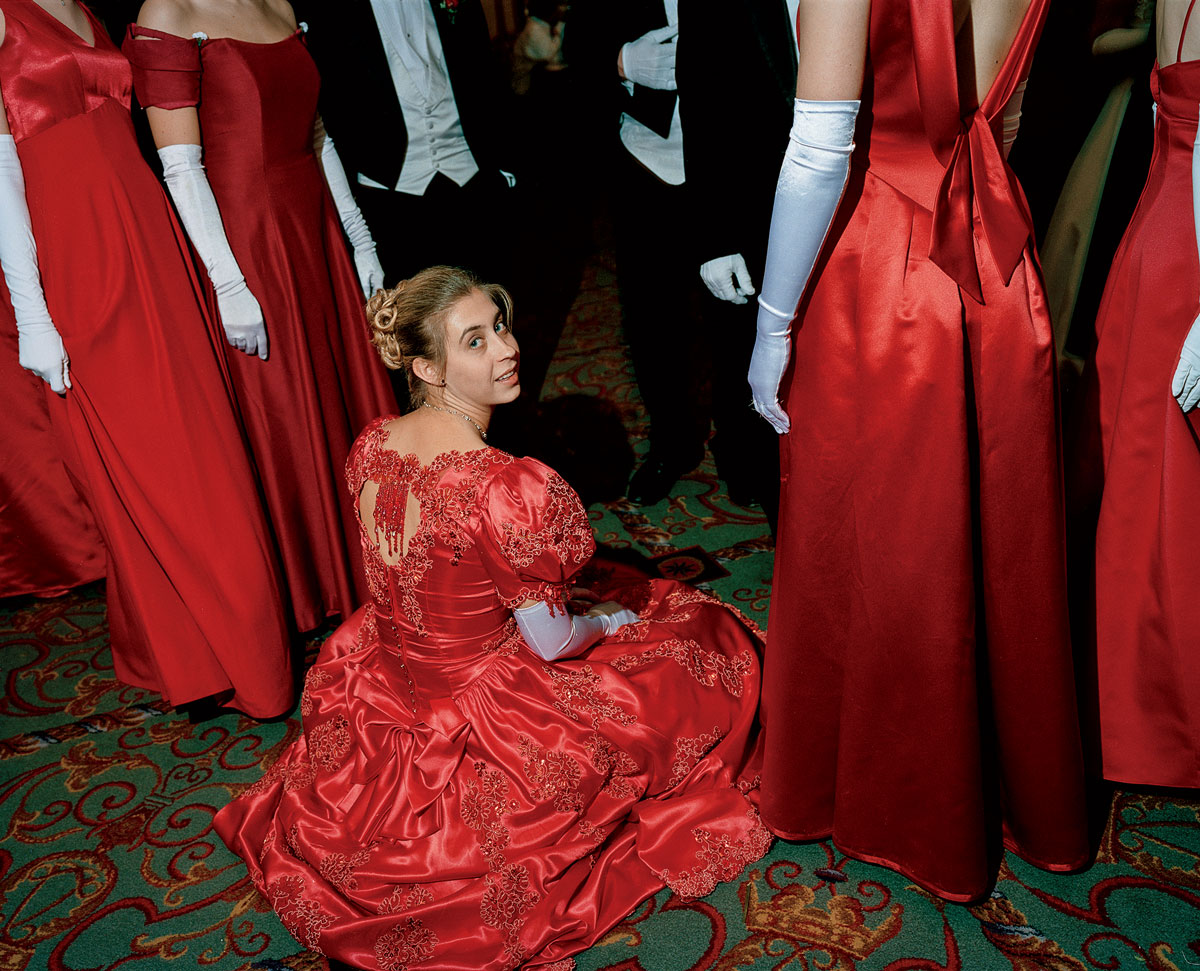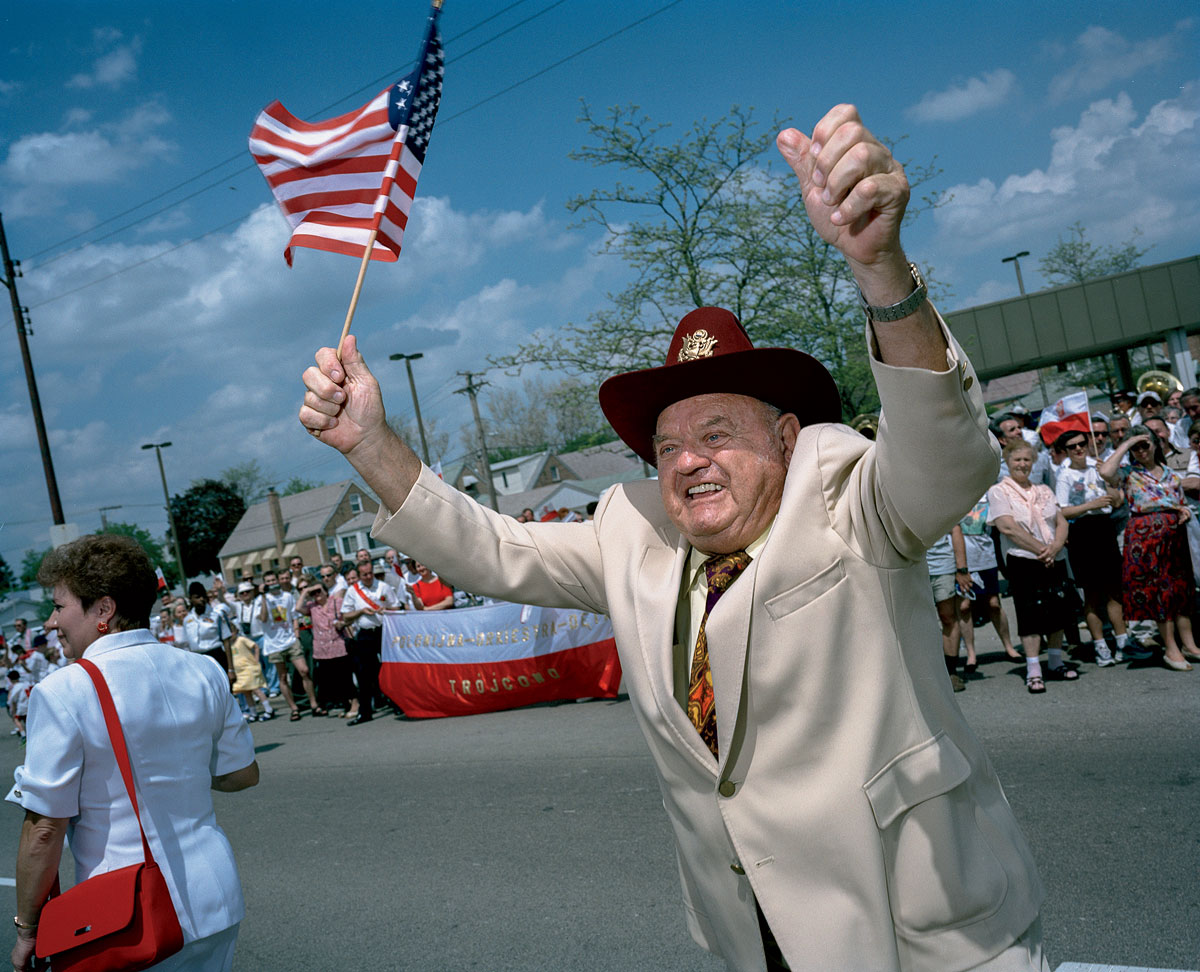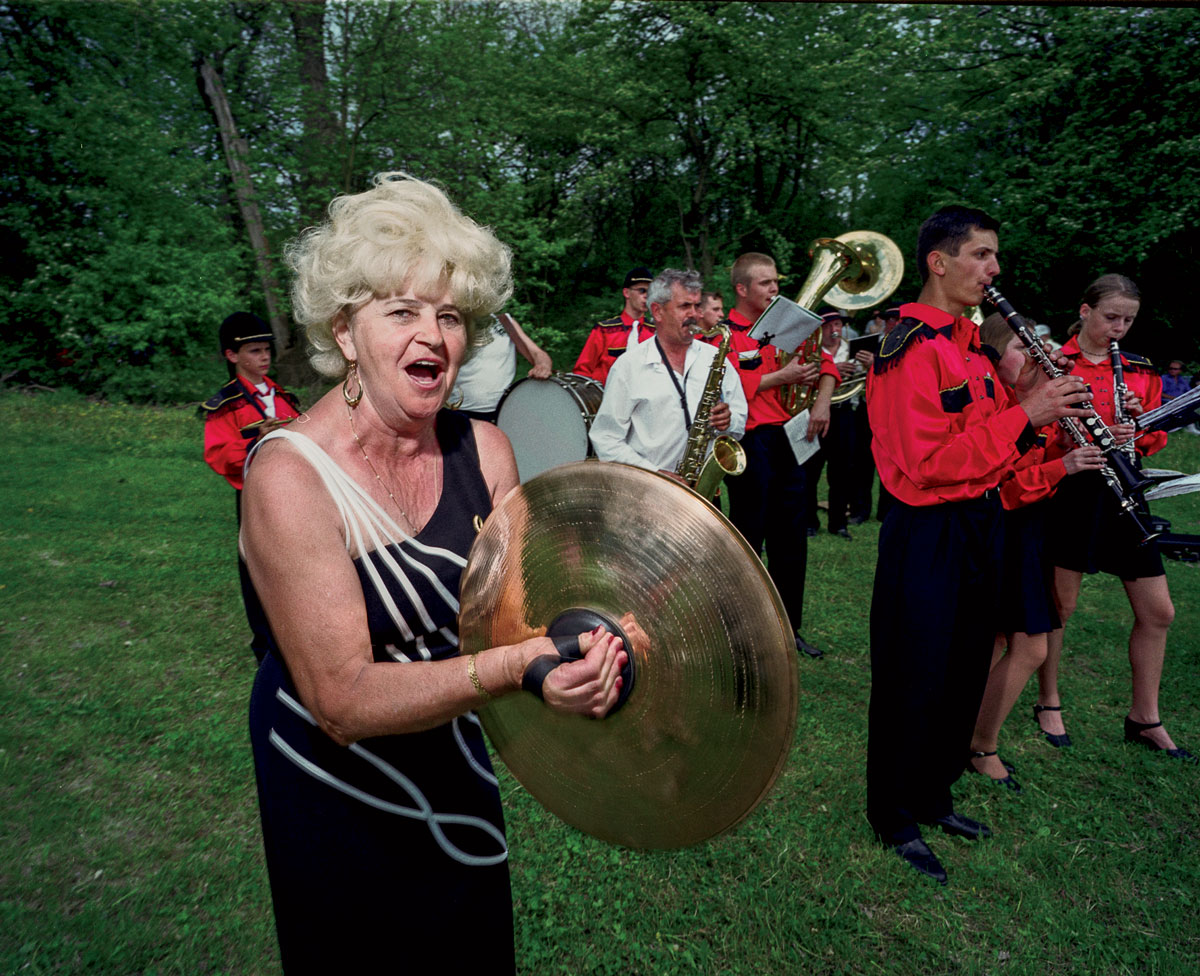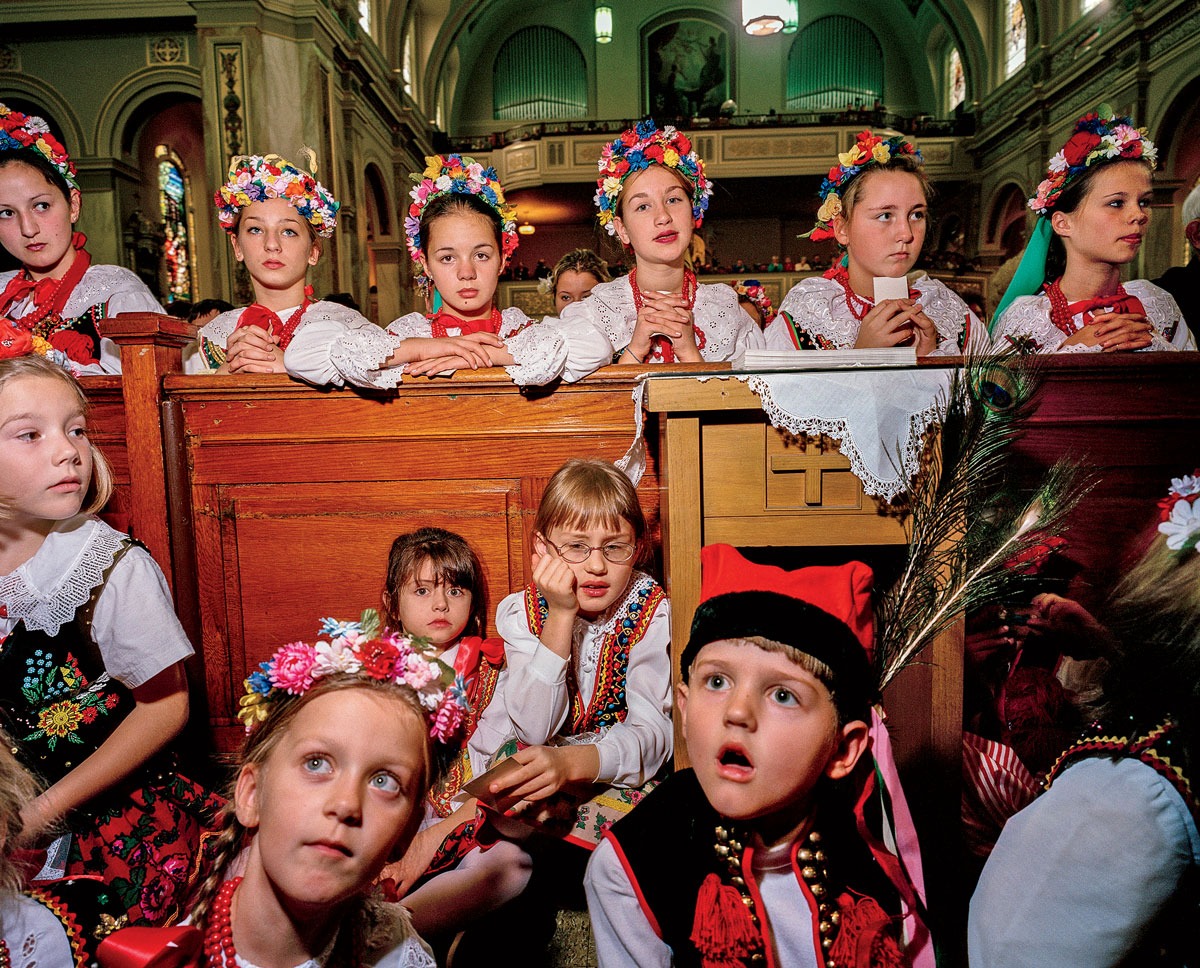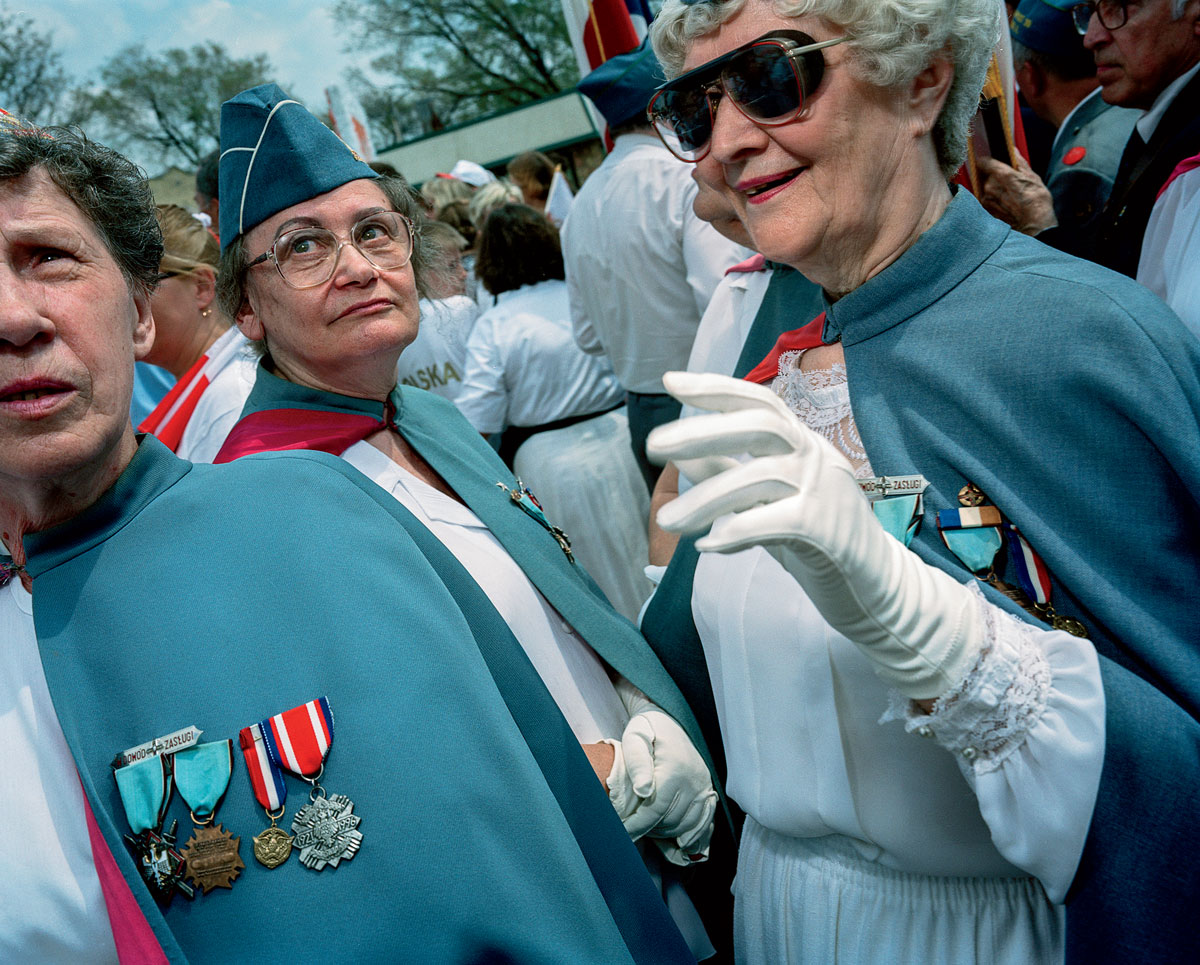At Bruno’s Barber Shop on Milwaukee Avenue in Avondale, owner Steve Ciesielski, a genial 53-year-old with bleached blond hair and beard, is showing off his new tattoo. An image of a straight razor, the kind that gets sharpened on a leather strop, it’s a symbol of both the old and the new. Steve’s father, Bruno, used a barber’s razor decades ago to service Polish immigrants who had fled Communism to haul boxes at the Florsheim shoe factory or cut meat in the Fulton Market district. Now hipsters who work on laptops and live in condo buildings like the Shoemaker Lofts, which was converted from the old factory in 2006, come to Bruno’s to sit in the old-fashioned red leather chairs, hot towels on their faces, awaiting the same lather and shave.
The shop has a funky, homey look, with hanging plants and paintings of ships and Pope John Paul II. New window decals to refresh the place are some of the last white-and-red accents in a neighborhood where once nearly every business displayed a Polish flag. Wearing a white barber’s jacket patterned with combs, brushes, and razors and standing over a lathered-up customer, Ciesielski chats about the reshaping of the neighborhood. “There’s nothing one can do. These changes are normal and inevitable. But Jackowo is a good area. It will bounce back — in a new form, though. They are coming, little by little,” he says, glancing at the new condos rising across the street.
Bruno’s is a survivor in Jackowo (pronounced yahts-KOH-voh), a patch roughly bounded by Diversey on the south, Belmont on the north, the Kennedy on the east, and the Union Pacific Northwest railroad tracks on the west. The name is derived from the neighborhood’s anchor parish: St. Hyacinth Basilica (the saint’s name translates to Jacka in Polish, and owo indicates “village”). Wacławowo (vahts-wa-VOH-voh), a less prominent Polish patch that runs from Belmont to Addison, is served by St. Wenceslaus Catholic Church. Together, they are known as the Polish Village. Most of this area falls within Avondale, except for a northern stretch in Irving Park.
Bronisław “Bruno” Ciesielski opened his shop in 1969, when he was 25, four years after he came to the United States. He was one of the only barbers around who would give young men haircuts that were hip for that time — that is, not crewcuts, but rather long over the ears and shaggy. From the windows of the shop at 3110 North Milwaukee Avenue, Bruno saw the rise of Jackowo, how it became the biggest and most important Polish neighborhood in the United States from the 1970s through the early 2000s — a source of funding and support for the Solidarity movement abroad and of political power here. It was a place of welcome for a new breed of Polish immigrants, many arriving on “vacation visas” and then staying for decades.
“If someone kidnapped you and blindfolded you and brought you to Jackowo, you’d think you were in Poland,” recalls Bruno, who is now retired. It was, as previous generations of immigrants had called their patches of the city, “Poland elsewhere.”

The center of Chicago “Polonia,” the term for Poles outside of Poland, had moved northwest in the 1960s along Milwaukee Avenue, from West Town to north of Diversey, and the late 20th century saw an explosion of immigrant culture, through book and music stores, doctors’ offices, florists, groceries, bakeries, restaurants, and nightclubs. Polish music stars would entertain thousands at the Maryla Polonaise or the Cardinal Club. George H.W. Bush stopped at St. Hyacinth’s on his campaign in 1988, followed by Lech Wałęsa, the leader of the Solidarity movement, on Palm Sunday of 1991, attracting such a huge crowd that it spilled onto the street. Karol Wojtyła visited St. Hyacinth’s both as a cardinal and as Pope John Paul II.
But in the last 15 years, the Polish population in Jackowo has dropped sharply. Many immigrants made their money and left for the suburbs, where they could have a bigger house and yard, along with what they hoped would be better schools and lower taxes. Some returned to Poland.
Neighborhood change is an old story in Chicago — one group moves out as another moves in. Avondale had become 62 percent Hispanic by 2000, with names by apartment doorbells changing from Nowak to Gonzales as immigrants from Guatemala, El Salvador, and other Central American countries brought their own bakeries and pharmacies, as well as new hymns for Roman Catholic Masses. Other ethnic groups, including Filipinos and Russians, also found homes in the area.
The challenge in Avondale is that while the immigrant businesses are leaving, new businesses have been slow to replace them. When a Mexican panadería replaces a Polish piekarnia, the neighborhood doesn’t lose much. It still gets fresh bread and cookies. But it’s troubling when both the Polish and Mexican shops are replaced with nothing — when shuttered stores and vacant lots mar the street like broken teeth, and homeless people sleep in boarded-up doorways. This stretch of Milwaukee from Diversey to Addison has become increasingly devoid of retailers in the last few years, even as pricey brick condo buildings rise.

The current state of the Polish Village offers a puzzle that goes beyond the familiar story of one group replacing another and offers a warning and a challenge for Chicago at large. Real estate writers have forecast for 15 years that Avondale would be the next hot market, as creative types and young professionals would get priced out of Wicker Park and Logan Square and move northwest. But while housing prices (along with tax assessments) are going up, the area seems stuck in transition, not one thing or the other. The Polish immigrant population has fallen, and a whiter, wealthier population is taking its place. Yet the business vacancy rate is as high as 40 percent, according to Alderman Ariel Reboyras, whose 30th Ward includes the strip of Milwaukee from Central Park to Addison.
“It’s kind of a perfect storm,” says Lynn Basa, who owns an apartment building on Milwaukee with an artist’s studio in a storefront that was once a sausage shop. She cites real estate speculation, overly high building prices and rents, and difficulties getting financing and zoning changes as contributors to the area’s problems, but she stays upbeat about the possibilities of reviving Milwaukee, the retail heart of the neighborhood. “Some people are going to look at our street and get discouraged by all of the vacancies, but there are others who have the imagination to see that these storefronts are full of opportunities.”
There’s more at stake here than just Jackowo’s fate. The city, neighborhood groups, and chambers of commerce must figure out a way to preserve diverse, lively, walkable neighborhoods like this one, with a mix of ethnicities and incomes, and easy access to public transit. They need to find the right mix of zoning, business support, affordable housing, and assessments that won’t tax people out. If they don’t, the city will devolve into a place with poor, underserved, crime-ridden neighborhoods in some areas, wealthy but bland neighborhoods in others, and chain stores dominating all. The reasons to live here will disappear.
The first Poles in Chicago were known as za chlebem immigrants because they came “for bread.” They were fleeing from poverty and foreign rule. By 1930, there were 400,000 Poles in Chicago, though immigration had slowed after 1924 because of a racist law that limited the number of Eastern European newcomers. The heart of the Polish community on the Northwest Side was at the intersections of Milwaukee, Division, and Ashland — the Polish Triangle. The ornate Roman Catholic churches of St. John Cantius, St. Stanislaus Kostka, Holy Trinity, and St. Mary of the Angels dominated the skyline, providing elementary and secondary schools, aid societies, and performance and meeting spaces, along with the sacraments. This is the area Chicago writer Nelson Algren described in his novels The Man With the Golden Arm and Never Come Morning — though not all residents appreciated his depictions of Polish immigrants as drunks, drug addicts, and prostitutes. They wanted those books banned from the Chicago Public Library.
Though West Town had the largest concentration, Poles had already begun settling in Avondale well before World War I. Founded by Resurrectionists from St. Stanislaus Kostka, St. Hyacinth was initially located at the southwest corner of Milwaukee and Central Park Avenues, before the original building was moved to between George and Wolfram Streets, according to Dominic A. Pacyga, historian and author of American Warsaw: The Rise, Fall, and Rebirth of Polish Chicago. The current basilica was built in the lavish Polish cathedral style between 1917 and 1921. St. Wenceslaus was founded to handle the overcrowding; its unique art deco and Romanesque building was finished in 1942.
By 1968, 400,000 Polish Americans had moved to the suburbs, estimated a Chicago Sun-Times report cited by Pacyga. In the city, the gravitational center of Polish immigrant life was shifting from West Town to Avondale. This was caused by various factors, according to Pacyga and Daniel Pogorzelski, the former head of the Greater Avondale Chamber of Commerce and coauthor of Avondale and Chicago’s Polish Village. The Northwest Expressway, finished in 1960 and later renamed the Kennedy, had smashed through the Northwest Side, forcing hundreds of parishioners of St. Stan’s, St. Mary of the Angels, and Holy Trinity to relocate. The population of West Town had also shifted in the ’50s to Hispanic. Then, in the ’80s, that neighborhood started to attract artists and musicians, who in turn attracted wealthy professionals. Newer immigrants working blue-collar jobs could no longer afford the prices, and they increasingly settled in Avondale.
The new waves of Polish immigration were caused in part by the 1980 Refugee Act, which expanded eligibility for political asylum. When the Polish government lifted martial law, activists there who had pushed for freeing the Eastern bloc came to the United States. Chicago saw an additional wave of those who had originally settled elsewhere in the country. These Poles, who had immigrated at the time of the Solidarity movement, were largely wakacjusze — undocumented “vacationers” who overstayed their visas. As many as 100,000 moved here, becoming construction workers, housepainters, maids, and nannies, or getting paid under the table at one of the many bakeries and restaurants along Milwaukee. Undocumented, they were often exploited by employers, including other Poles. “I asked a guy who was working on my house how long he’d been on vacation,” says Pacyga. “He told me 26 years.”
Young immigrants in the ’80s and ’90s would crowd into group apartments, where a mattress on the hallway floor could serve as a bedroom. A single six-room flat might be a home for a dozen contractors, cleaning ladies, and bakery workers, all doing various shifts. Curtains acted as dividers for privacy. “People were living in basements, in every hole that could be made into a living space,” says Bruno Ciesielski.

Avondale wasn’t seen as a fashionable place to live — its parks are few, and its architecture is low and rather bland, mostly consisting of bungalows, courtyard apartment buildings, and two- and three-flats. But it was cheap, and transportation was easy, with two Metra stations, the Blue Line, the Belmont and Milwaukee Avenue buses, and the Kennedy all nearby. Its factories also provided an abundance of blue-collar jobs. The Florsheim factory once employed 2,500 people. Other big employers were Bally Manufacturing, the pinball and slot-machine maker; I.S. Berlin Press; and the Maurice Lenell cookie factory.
Immigrants who hadn’t yet found a regular job could get work as day laborers by standing in a gas station parking lot at the southeast corner of Milwaukee and Belmont early in the morning, waiting for contractors who needed help. Up to a hundred people would gather at once in the location, which became known as the ściana płaczu, or “wailing wall,” recalls Margaret Kulujian, a Warsaw-born journalist who worked at the Polskie Radio and Polvision station on Belmont. Those who ran out of grocery money before the end of the week could go to Stanley’s Sausage Shop on Belmont and buy vegetables and rye bread na krechę — on a tab.
Many who started out by doing factory or bakery or construction work would save enough to buy property and open their own businesses, filling Milwaukee Avenue and other arteries with shops that brought in large crowds on the weekend, including suburban Poles, who still wanted to attend Mass at their old parishes and couldn’t find decent rye bread and kielbasa outside the city.
Danuta Pluta, who emigrated from Poland in 1980, made her fortune hosting dances at the Podlasie Club at 2918 North Central Park Avenue, which she and her husband took over in 1986. She remembers that in the ’80s and ’90s, there were live bands every Saturday and Sunday night. People would come after Mass at St. Hyacinth’s and stay all day. The room, with its pink fabric tablecloths and flower centerpieces, would fill with cigarette smoke and disco lights. Polish ladies and gentlemen would swap their sweaty work clothes for their best Sunday outfits. Pluta recalls how members of the Avondale Roma community would throw $100 bills at the band to keep them playing, and parties would last until 4 in the morning. “People lived in group apartments and worked very hard Monday to Friday,” she says. They sent most of their earnings to their families back in Poland. By the weekend, they were ready to cut loose.
A Night on Milwaukee Ave., a 2018 documentary by Adrian Prawica, recounts Jackowo’s abundant nightlife during a time when young immigrants would line up by the hundreds outside clubs to catch Polish acts like Czerwone Gitary, Kombi, Czerwono-Czarni, Krzysztof Krawczyk, and Stan Borys. There would be boys in black leather jackets with Polish flag patches on the shoulders and girls with short skirts, high heels, and long, hennaed hair. Inside the Maryla Polonaise were mirrors, purple and pink neon lights, smoke, lasers, and strobes. The Cafe Lura was decorated with murals; artificial grapevines hung on overhead trellises. Beer and vodka flowed freely.
For those not disposed to rock and techno, there were folk dancing lessons at Avondale Park, readings by authors like Nobel laureate Czesław Miłosz at the Polonia Bookstore, and Polish films at the Milford Theatre. “It was a unique flowering of Polish culture,” says Pogorzelski. “Poles could finally express themselves without worrying about incurring the wrath of government censors. This is where so many Polish Americans started their American journey.”
Bruno Ciesielski was part of that music scene. The barber played drums at night for 20 years in local bands. In 1984, Steve, who had grown up sweeping hair off the floor of his father’s shop, also became a barber. Fifteen years later, they opened a second shop, in Edison Park, following the Poles who had moved northwest. Steve married a girl who worked at Toys and Gifts, a store next door to Bruno’s in Jackowo.
“America gave me a better life for my whole family,” Bruno says. Using money made in Chicago, he bought a house for his parents back in Poland, paying just $900 in 1985. He also helped his brothers buy their homes and cars and brought his sister to the United States. “I have to say I am proud of myself.”

Stanisława “Stasia” Jóźwiak emerges from the back room of Szarotka Flowers, her meticulously maintained shop on Milwaukee Avenue. There are large vases of tall lilies on the floor and rolls of colorful ribbons hung behind the counter. But no customers.
Jóźwiak cleaned for a living after coming to Avondale in 1989. But she missed her job as a florist in Poland, so she took a part-time position at Szarotka. In 1996, she bought the business — on August 15, the Feast of the Assumption, which is celebrated in Poland as a day dedicated to the Divine Mother of Herbs. “Flowers, herbs — this was a sign,” says Jóźwiak.
The 67-year-old now lives in Niles, but her passion for flowers and sentiment for the old neighborhood bring her back every day to the storefront she rents on a block once full of Polish businesses. She sometimes goes days without a sale. The coronavirus pandemic cut into wedding celebrations, and the wholesale cost of flowers has gone up. Customers don’t want to pay for custom arrangements when they can buy a $10 bunch of roses at Jewel. “I don’t know how much longer I can be here,” says Jóźwiak. “Business doesn’t even pay for the rent. But flowers are my life.”
Her store is not the only fixture in Jackowo that’s tottering. European Draperies, Jadwiga Sobieska’s shop at 3050 North Milwaukee Avenue, is open, but you have to ring the bell to get in. Sobieska, who lives in the backroom, also goes long stretches without customers. At one point, she was offered $200,000 for the business. She thought about it and decided the shop was not just a business, but her life. “I built it from scratch, put my hands and my heart in it. So when he called for an answer, I just cried.” Now she’d like to sell and go back to Poland when the pandemic is over.
Jackowo stopped being the city’s last great Polish neighborhood the way Ernest Hemingway once described going bankrupt: gradually, then suddenly. Some residents name 2001 as the year the decline began, when the September 11 attacks made it more difficult to travel. Others place it in 2004, when Poland joined the European Union, slowing the flow of immigrants to Chicago and encouraging many Poles to return to a more economically vibrant homeland. Either way, the downturn began as the immigrant population declined. “They’re either dying or moving north to Niles,” says Alderman Reboyras.
In 2000, Zbigniew Bzdak documented the Polish diaspora in Chicago for CITY 2000. That yearlong project, conceived by Gary Comer and funded by the Comer Foundation, enlisted more than 200 photographers to capture everyday life throughout the city.
Businesses that formed the core of Jackowo started disappearing. The neon Maryla Polonaise sign, with the picture of a blond girl emerging from a swirl of color, stopped glowing more than 20 years ago. Animal Kingdom, the giant Milwaukee Avenue pet store that was home to Chelveston the Duck from Ray Rayner’s show on WGN and Luther the Leopard from magic acts, shut down in 2009 when its owners retired. The Calisia Gift Shop is gone, as are Cafe Lura and the Toys and Gifts store. The 75-year-old Pasieka Bakery, the best local source for challah bread, kolacky, and paczki, along with gorgeous rum-flavored wedding cakes, burned to the ground in 2011. Longtime residents wept over the ashes. An apartment building has taken its place.
The losses have accelerated in recent years. La Farine, Sugar Hills Bakery, and Panaderia Azucar all shut down in 2018. Red Apple Buffet, a cheap destination for cops, Polish Americans, and ethno-curious diners from around the city, closed its Avondale location in 2019. The Polskie Radio and Polvision building on Belmont was demolished last summer. Both are being replaced by condo buildings, developed by Wilmot Properties, which is owned by Stanisław Pluta, Danuta’s son.
Unlike his mother, Stan is not mourning the losses. “The neighborhood is changing — one people come, other people leave,” he says. “It was the same in the old Polish Triangle. For sure, there’s a bit of sentiment — that Polish people used to be there. But now Poles can’t afford to return to Jackowo. It’s too expensive for them.”
One of the biggest blows to the community was the closing of Wally’s International Market, a large grocery store at 3256 North Milwaukee Avenue. For years afterward, homeless men slept in the entryway. Then the building was demolished, leaving a wasteland of concrete and ghostly brown tile from the store’s bakery section, all enclosed by a metal fence. Weeds and young trees are growing through the cracks.
In 2004, with his wrist bothering him, Bruno Ciesielski retired from barbering and returned to Poland, something he’d dreamed of doing since he moved to Chicago in 1965. He now lives like an old-time nobleman on his American savings, overseeing a nearly 50-acre estate near his hometown with a flower garden, a forest, and a pond. He has carp, pigeons, and peacocks. “I keep busy,” he says. He has come back to the United States only twice.
Danuta Pluta, who at 79 still owns the Podlasie Club and lives in the apartment above, doesn’t get why so many immigrants and their children would leave friendly, walkable Avondale: “When they praise the suburbs over Jackowo, I tell them, ‘You basically want to live in a cornfield.’ ” But Kulujian understands why some choose different paths: “If you’re an immigrant, you live in a few realities at the same time. Many people feel they are here temporarily.”
The departure of Poles from their Avondale stronghold in particular and Chicago in general has meant a major loss of political clout. As the neighborhood became more Hispanic, Mayor Richard M. Daley eased out its Polish alderman, Michael Wojcik, to make room for Reboyras in 2003. Now the only City Council member with a Polish name is Susan Sadlowski Garza, from the Southwest Side’s 10th Ward. The city clerk’s position used to regularly be filled by a Pole, until Jim Laski was indicted in the Hired Truck scandal and resigned in 2006. Congressman Dan Lipinski lost his seat in 2020.
By scattering to the suburbs, the Poles no longer have a concentrated center of power and can’t advocate Polish causes, Pacyga says. They also weakened their ability to promote Polish culture and save important historic and cultural landmarks. “If you’re in Justice or Niles or Naperville, you might elect a city representative, but in Chicago, that means bupkis,” says Pacyga.

Take a walk on Milwaukee in old Jackowo these days and you’ll find that the once-bustling sidewalks are mostly empty, and often narrowed by builders’ scaffolding. The only Polish you’ll hear is from construction workers, putting up multistory condo buildings on the sites of demolished immigrant businesses.
Prices for the new condos rising on Milwaukee and Belmont are relatively steep. At the Milford, a development at 3065 North Milwaukee Avenue, all 17 sleek, modern units, with quartz countertops and steam showers, sold for between $525,000 and $550,000, says listing broker Staci Slattery. “The buyers were primarily young professionals,” she says. There were no Polish names. Avondale housing prices are among the fastest growing in the city. In Jefferson Township, which includes the neighborhood, median sales prices for two- to six-flat buildings have almost doubled in six years, from $220,000 in 2014 to $430,000 in 2020.
While there are plenty of shiny new buildings available along Milwaukee, with ads in the windows ballyhooing hardwood floors, steam showers, and rooftop decks, there are relatively few nearby places to eat and go shopping. Local business owners, politicians, and neighborhood activists point to a variety of causes.
One issue is that owners of commercial real estate who are waiting for a big payout in a gentrifying neighborhood sit on their empty properties, contributing to a loss of foot traffic and to urban decay. “People have heard that we’re the next hot neighborhood, because they see what’s going on down the street, past Diversey,” says Lynn Basa, pointing south from her art studio at Milwaukee and Drake. “So they’re hoping for Starbucks or Panera Bread. And they keep them vacant and speculate, because they have enough other property or they have apartments above.”
Another issue is that older buildings have deteriorated, and the owners can’t get the loans to fix them up or can’t get a zoning change. “With some people, their storefronts aren’t vacant because they’re living there, and it creates these long stretches of dead zones,” says Basa, who, as founder and executive director of the Milwaukee Avenue Alliance, pays close attention to the neighborhood’s problems.
Alderman Reboyras agrees that real estate speculators are partly responsible for the empty storefronts. “They’re just waiting for the day when they get an offer. If [a property is] not leased, it’s not rented, the taxes are lower. That’s just the law.” But should it be? Basa doesn’t think so: “There needs to be policies that encourage people to rent their storefronts. People don’t want to invest, because they come here and there’s so many vacancies and there’s no people here, and they say, ‘I’m not going to open anything without walk-in traffic.’ It becomes this vicious circle.”
Some buildings, Pogorzelski points out, are owned by real estate trusts or out-of-state landlords that aren’t invested in what happens to the neighborhood. “The spirit of the law is that you should try to rent in good faith, but they’ll turn folks away interested in renting because they can deduct it,” he says. “I know someone who had to leave Avondale because the owner died, the kids sold the building, and the new landlords wanted top dollar, so sayonara.”
It’s the kind of urban planning puzzle that would have interested the late Jane Jacobs, author of The Death and Life of Great American Cities. Jacobs argued that to have a vital, walkable urban neighborhood, you need density, a diversity of incomes and building uses, and a mix of old and new buildings. She would not have thought much of giant vacant lots with fences around them, or blocks of boarded-up stores, or new condo buildings with no retail space.
Reboyras’s fellow alderman Carlos Ramirez-Rosa is trying different strategies to solve the problem. In addition to building affordable housing, Ramirez-Rosa, whose 35th Ward includes central Avondale south of Central Park Avenue, hopes that selective downzoning will prevent land speculation while preserving older buildings and the look of the neighborhood.
Here’s how it works: A two-story building with an empty storefront was zoned for four stories. So its owner might keep it vacant, waiting for a buyer who wants to knock it down and replace it with a four-story building. This encourages speculation, says the alderman. With community input, zoning can be changed on some two-story sites to allow for only a three-story building, which takes away some incentive to tear down the original structure. “We want to make it clear to property owners to begin activating their buildings and use them for what they are right now,” he says.
Reboyras, though, scoffs at downzoning. He says he likes the idea of five- or six-story buildings because they bring in foot traffic and will keep the neighborhood affordable: “The only way to rebuild the business community is to add density. How do you do that? Allow them to build up.”
His office is working with the city’s Department of Planning and Development to figure out what to do with the big empty space created by the departure of Wally’s and neighboring businesses, but there’s not much to report yet. Department deputy commissioner Peter Strazzabosco says that the city is looking at “multiple community-based planning strategies to help maximize Milwaukee Avenue’s historic role within the neighborhood, including a request for proposals for one or more development sites, as well as a formal corridor study that could extend from Logan Square to Jefferson Park.” The city is also planning to reconstruct Milwaukee from Belmont to Diversey, with new pedestrian, bike, bus stop, landscaping, and lighting improvements, says Department of Transportation spokesman Mike Claffey.
One point of contention among Avondale residents has been the city’s greenlighting of projects in which developers tear down old houses on double lots in the middle of residential streets to put up boxy condos that block out the sun, says real estate agent Liz Muscare, president of the Avondale Neighborhood Association and a lifelong resident. Ugly developments blight the landscape, she says, noting that when PNC Bank replaced its building on the northeast corner of Milwaukee and Belmont with a parking lot with drive-through teller lanes, it made the intersection worse for pedestrians. “It was a battle we lost,” she says.
Muscare is part of a team of businesses that is creating a new Avondale chamber of commerce, and the Avondale Neighborhood Association is working with the Chicago Metropolitan Agency for Planning to come up with a strategy for the neighborhood. They’ve put together a diverse committee to collect data from residents. “We want boots on the street in the community who can tell us what they want,” Muscare says.
Neighborhood boosters still see promise in the community, as long as affordable housing is maintained and business is supported. Logan Square Chamber of Commerce executive director Nilda Esparza has been driving prospective business owners to the area to see vacant properties. Part of the difficulty has been tracking down contact information for owners of those properties, and she wishes the city could do more to help.
Basa, who created the light sculpture at the corner of Milwaukee and Wood in West Town and the mosaic at the Argyle CTA Red Line stop, finds hope in cultural destinations like the Puerto Rican Arts Alliance, Elastic Arts, and the Extraordinarium, a funky shop in the Hairpin Arts Center at Milwaukee and Diversey. Uprising Theater is coming to the area, too.
The Milwaukee Avenue Alliance, working with the Logan Square Chamber of Commerce, is trying to bring in more women- and minority-owned businesses, as well as other attractions, such as festive lights along and above the street. To honor both the wave of immigrants who came at the time of the Solidarity movement and those who came after, an ordinance is expected to be introduced this year to change the name of the plaza on the northeast corner of Milwaukee and Diversey to Solidarity Triangle, says Pogorzelski, who pushed the idea.
Basa sees the possibility of Milwaukee Avenue becoming more of a draw again: “It’s a well-preserved traditional urban main street, made for walking.” But its rebirth is largely a question of aesthetics and ingenuity, she says. “We want people to come here. They’re not going to come here if it looks like everywhere USA. People have to have the imagination to invest in the street and not say, ‘I’m going to buy this and hope that Starbucks moves here.’ If Starbucks wanted to be here, they’d have been here by now.”
The old mix of small ethnic groceries, clothing stores, and furniture outlets will likely never return. “Our customs change,” notes Kulujian. “If I wanted to open a little Polish kielbasa store, will the people in the neighborhood come? Nobody’s eating kielbasa anymore because it’s not healthy.”
But there are signs of life in some of the newer businesses that have set up shop. Brew Brew Coffee & Tea, owned by a brother and two sisters from Mexico, has done well across from Kosciuszko Park since setting up shop in 2014. Sipping Turtle Cafe at Central and Milwaukee offers Asian-style bubble teas and bagels with wasabi mustard. More recently: The old shot-and-a-beer tavern next to the Podlasie Club has been renovated and turned into the Central Park Bar; newcomer Avondale Bowl at 3118 North Milwaukee Avenue was built on the site of a bowling alley from the 1950s; Vintage Frills, a retro clothing and home goods store, opened on Milwaukee in August; the New York City bar Mother’s Ruin is opening a location in an old Polish restaurant; Bric-a-Brac Records is also headed to the stretch.
So what does that leave from the old neighborhood? The businesses that will likely remain are those that offer something distinct that appeals to the new crowd as much as it did to the old one. Like Staropolska Restaurant at 3030 North Milwaukee Avenue, a cozy place with exposed brick, wood beams, hanging vines, and wooden roosters that serves pierogi, potato pancakes, and other Polish fare. But Barbara Orzeł, who has owned the restaurant with her sister Zofia Zaborska since 2002, says Poles were never her target customers, since they tend to cook at home. Rather, her customers are diners who want to try something different. And there are plenty of those in Chicago. Some nights, the place is so packed you have to eat at the bar. “We are planning to stay,” she says.
The same goes for Regina & Joe Tap, a tavern a block south. “There will always be a need for a neighborhood bar,” says owner Joe Nowak. “I have bottles of beer for $4. Now imagine, same beer in downtown costs $12. So I am not worried.”
Steve Ciesielski also isn’t going anywhere. At his old-time barbershop, he provides something unique to his new hipster base: “I am a pro at hot shaves. Not every barber knows how to do it. On Friday, I had three new customers — all were happy, and said they’d come back.”
But even as Ciesielski sees old memories replaced by new customers, even as he watches the four-story condo building rising in place of the Red Apple Buffet across the street, he keeps close by reminders of Jackowo the way it used to be. In the back of the shop hangs a photo of his father in a tux playing drums for the Continental Combo.
Mary Wisniewski is a Chicago writer and the author of the biography Algren: A Life. She is a former Jackowo and current Wacławowo resident. Joanna Marszałek, also a former Jackowo resident, is a bilingual journalist for the Dziennik Związkowy (Polish Daily News)



